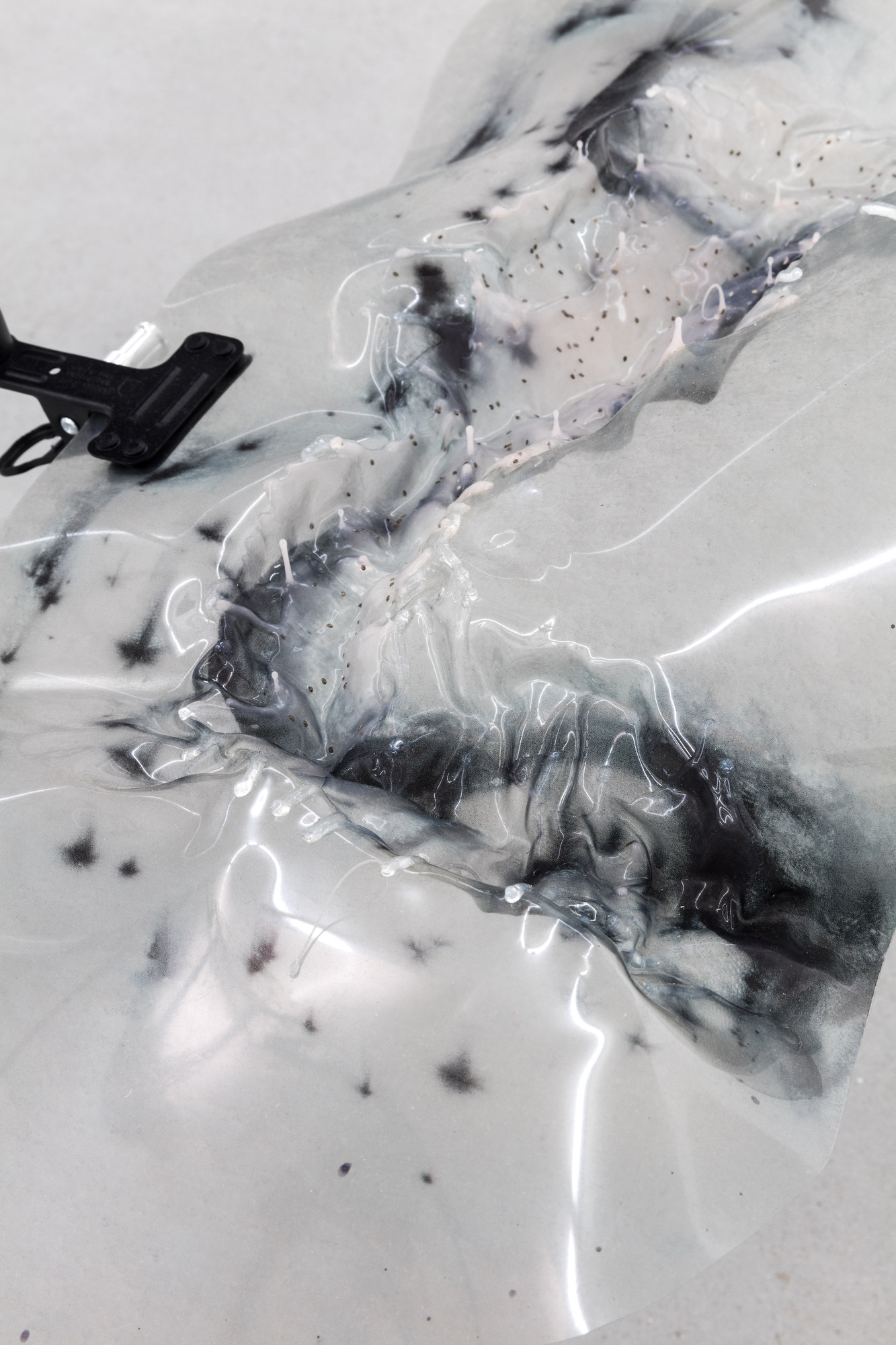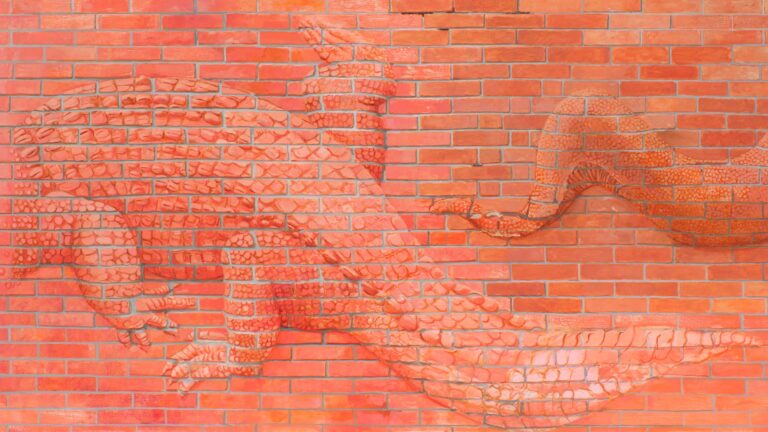Artists: Julieta Aranda, Iain Ball, Kate Cooper, Pakui Hardware, Estrid Lutz & Emile Mold, Aude Pariset
Exhibition title: Hard to explain (the promise that was never made, reality that had to be imagined)
Venue: Future Gallery, Berlin, Germany
Date: November 4 – December 9, 2017
Photography: all images copyright and courtesy of the artists and Future Gallery, Berlin
Future Gallery is proud to present the group exhibition Hard to Explain (the promise that was never made, reality that had to be imagined), featuring works by: Julieta Aranda, Iain Ball, Kate Cooper, Pakui Hardware, Estrid Lutz & Emile Mold and Aude Pariset.
This exhibition showcases a selection of third wave digitally fueled material propositions such as: polygon explosions from the head, iconic geometric transdimensional portraits, CGI interpersonal dialogues, space goop on transparent sheets of outer space, indecipherable lenticular collages, forgotten digital paintings layered onto synthetic seashells. The works deal with the (digital) body in a post-human context forming visual questions about our increasingly post-natural conditions.
In Julieta Aranda’s work A fanciful strategy? I might have known better…,(2015) she 3D scanned a bust from a museum in Genoa and digitally edited it into a new sculpture. The works is a visualization of the actual translation process from a human head to digitally malleable data, half rendered flesh the other half simplified polygon textures. Polygons are three dimensional pixels, infinitely scalable and editable in rendered space. This sculpture is part of larger body of work entitled If A Body Meet A Body in which she focuses on bodies meeting each other and on the infinite possibilities such encounters generate.
Iain Ball’s LUTETIUM (2017) sculptures are part of the Rare Earth Sculpturesseries which are ndimensional polytopes designed by Hedrondude via polytope.net. The dataset was transferred and modeled into forms of plastic. Each of the three sculptures comes with a different set of physical laws. Both, the infinite expansion or the destruction, is possible within the sculptures sets. Referring to Bruno Latour’s concept of blackboxing, the structures tend to increase their complexity when a greater scientific insight is made.
We Need Sanctuary (2016) by Kate Cooper examines the relationship between physical bodies and networks through the use of computer-generated technology. The history of digital image technology and immaterial labor politics are investigated as a part of commercial production. By showing highly-productive female bodies that are trying to sabotage and refuse the contemporary modes of exploitative labour Cooper questions the history of female labor politics. Within a contemporary digital working profile she explores our understanding of the bodily effects of capitalism. Her video examines the body as a contested space for communication and representation.
Pakui Hardware’s On Demand (2017) series deals with the conditions of human existence in an technological society under scientific advancement. The works can seen as hand-made ‘devices’ which could be used in potential near future scenarios. They start with magnified aerial NASA photographs of surfaces in outer space which are molded into hybrid erratic skin-like structures. The duo play with artificially produced surfaces whose appearances refer to a natural domain. Man-made and artificial materials are transformed by natural forces and matter – heat, weight, chia seeds, sea urchin spines or soil.
Estrid Lutz & Emile Mold present a new series of lenticular image collages. Each work is an amalgam of several layers of materials: fibers and resins, a crashed car radiator, a print and a lenticular screen. Combined and merged they serve the apparition of a shifting unified collection of associative imagery. Lenticular flip technique is usually limited to only two images. In this case, saturating the medium by using at least six images graft to one another allows for a wider comment on the represented subjects by extracting them from their original media environment and affective context. The works are photographic objects, the lenticular elements merging via manual destruction with a background layer of metal debris. Working at the edge of photography and sculpture, the duo challenges the boundaries of contemporary image/object making.
Aude Pariset’s FX Tridacna works (2015) are reanimations of, now obsolete, digital paintings sourced from the blog Paint FX, a collective image sharing Tumblr where digital sketches and paintings were proposed. Pariset begins with these images as the source material for her rice paper prints which are then adhered onto a molded mesh seashell form. It projects a disused digital file onto a cast of a natural form resulting in a digital material mashup, both collage and sculpture.
Hard to explain (the promise that was never made, reality that had to be imagined), 2017, exhibition view, Future Gallery, Berlin
Hard to explain (the promise that was never made, reality that had to be imagined), 2017, exhibition view, Future Gallery, Berlin
Hard to explain (the promise that was never made, reality that had to be imagined), 2017, exhibition view, Future Gallery, Berlin
Hard to explain (the promise that was never made, reality that had to be imagined), 2017, exhibition view, Future Gallery, Berlin
Hard to explain (the promise that was never made, reality that had to be imagined), 2017, exhibition view, Future Gallery, Berlin
Hard to explain (the promise that was never made, reality that had to be imagined), 2017, exhibition view, Future Gallery, Berlin
Hard to explain (the promise that was never made, reality that had to be imagined), 2017, exhibition view, Future Gallery, Berlin
Hard to explain (the promise that was never made, reality that had to be imagined), 2017, exhibition view, Future Gallery, Berlin
Hard to explain (the promise that was never made, reality that had to be imagined), 2017, exhibition view, Future Gallery, Berlin
Hard to explain (the promise that was never made, reality that had to be imagined), 2017, exhibition view, Future Gallery, Berlin
Hard to explain (the promise that was never made, reality that had to be imagined), 2017, exhibition view, Future Gallery, Berlin
Hard to explain (the promise that was never made, reality that had to be imagined), 2017, exhibition view, Future Gallery, Berlin
Hard to explain (the promise that was never made, reality that had to be imagined), 2017, exhibition view, Future Gallery, Berlin
Hard to explain (the promise that was never made, reality that had to be imagined), 2017, exhibition view, Future Gallery, Berlin
Hard to explain (the promise that was never made, reality that had to be imagined), 2017, exhibition view, Future Gallery, Berlin
Hard to explain (the promise that was never made, reality that had to be imagined), 2017, exhibition view, Future Gallery, Berlin
Hard to explain (the promise that was never made, reality that had to be imagined), 2017, exhibition view, Future Gallery, Berlin
Hard to explain (the promise that was never made, reality that had to be imagined), 2017, exhibition view, Future Gallery, Berlin
Kate Cooper, We Need Sanctuary, 2016, HD video, 3.55 min
Hard to explain (the promise that was never made, reality that had to be imagined), 2017, exhibition view, Future Gallery, Berlin
Iain Ball, Gin (Lutetium), 2017, Printed plastic, 24 x 24 x 24 cm
Iain Ball, Gin (Lutetium), 2017, Printed plastic, 24 x 24 x 24 cm
Pakui Hardware, On Demand IX, 2017, Heat-treated plastic, silicone, soil, transparent UV lacquer prints on PVC Pentaprint film on two metal holders, 190 x 88 x 44 cm
Pakui Hardware, On Demand IX, 2017, Heat-treated plastic, silicone, soil, transparent UV lacquer prints on PVC Pentaprint film on two metal holders, 190 x 88 x 44 cm
Pakui Hardware, On Demand IX, 2017, Heat-treated plastic, silicone, soil, transparent UV lacquer prints on PVC Pentaprint film on two metal holders, 190 x 88 x 44 cm
Pakui Hardware, On Demand X, 2017, Heat-treated plastic, silicone, chia seeds, sea urchin spines, transparent UV lacquer prints on PVC Pentaprint film, metal holders, 165 x 150 x 80 cm
Pakui Hardware, On Demand X, 2017, Heat-treated plastic, silicone, chia seeds, sea urchin spines, transparent UV lacquer prints on PVC Pentaprint film, metal holders, 165 x 150 x 80 cm
Pakui Hardware, On Demand X, 2017, Heat-treated plastic, silicone, chia seeds, sea urchin spines, transparent UV lacquer prints on PVC Pentaprint film, metal holders, 165 x 150 x 80 cm
Pakui Hardware, On Demand X, 2017, Heat-treated plastic, silicone, chia seeds, sea urchin spines, transparent UV lacquer prints on PVC Pentaprint film, metal holders, 165 x 150 x 80 cm
Pakui Hardware, On Demand X, 2017, Heat-treated plastic, silicone, chia seeds, sea urchin spines, transparent UV lacquer prints on PVC Pentaprint film, metal holders, 165 x 150 x 80 cm
Estrid Lutz & Emile Mold, ghost banding (server side), I, 2017, glass fiber, aluminum honeycomb, pigment print on photographic paper, adhesive foil, lenticular sheet, 145 x 103 x 35 cm
Estrid Lutz & Emile Mold, ghost banding (server side), I, 2017, glass fiber, aluminum honeycomb, pigment print on photographic paper, adhesive foil, lenticular sheet, 145 x 103 x 35 cm
Estrid Lutz & Emile Mold, ghost banding (server side), I, 2017, glass fiber, aluminum honeycomb, pigment print on photographic paper, adhesive foil, lenticular sheet, 145 x 103 x 35 cm







































